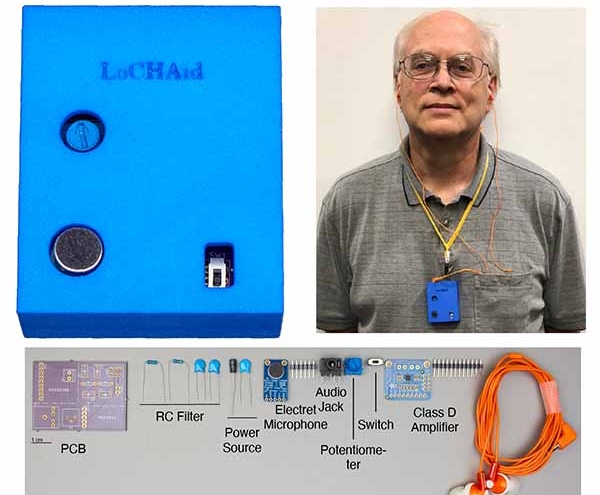LU audiology professor plays role in developing affordable hearing aids
September 29, 2020 | by Shelly Vitanza
Dr. Vinaya Manchaiah, Jo Mayo Endowed professor of speech and hearing sciences at Lamar University, joins a national team that has designed hearing aids that cost less than a dollar. Manchaiah was invited to join the research initiative because of his work to develop and test accessible and affordable solutions to people with  hearing loss and tinnitus.
hearing loss and tinnitus.
Aimed at helping millions of older people worldwide who suffer from moderate age-related hearing loss, the research team has developed an ultra-low-cost, proof-of-concept device known as LoCHAid. Made from a dollar’s worth of open-source parts and a 3D printed case, LoCHAid look like wearable music players and are expected to meet World Health Organization requirements for hearing aids.
“My work focuses on developing and testing accessible and affordable solutions to people with hearing loss and tinnitus,” said Manchaiah.
As co-founder of the Global Audiology Initiative, Manchaiah has worked to develop hearing solutions for people worldwide. Because of his renowned contribution in the field of audiology, Manchaiah was contacted by Dr. M. Saad Bhamla, School of Chemical & Biomolecular Engineering, Georgia Institute of Technology, to work collaboratively to develop affording hearing aids.
“I provided input in refining the hearing aid based on acoustic characteristics to meet the needs specific to age-related hearing loss,” said Manchaiah. “We tested multiple prototype devices in our lab for various acoustic characteristics - gain, frequency response, distortion, internal noise - and benchmarked them against the standards. This helped provide feedback to engineers who were building a device with optimized acoustic properties.”
Manchaiah said the published results described September 23 in the journal PLOS ONE, are based on lab studies. The researchers now have approval to perform clinical trials which will be conducted at Lamar University, in India and in Malawi.
The hearing aids researchers soldered together in the lab that only cost $0.98 to manufacture (does not include assembly and distribution costs), are larger than most manufactured hearing aids, have an expected lifetime of a year and a half and don’t have the ability to adjust frequency.
The researchers are now working on a smaller version that will increase the cost to $7 and require sophisticated manufacturing.
“This initiative is based on ‘frugal science’ principles,” said Manchaiah. “The project demonstrates that we can develop low-cost solutions with good acoustic quality benefiting those who are underserved.”
Manchaiah believes the LoCHAid initiative sets precedence for developing future solutions to worldwide problems.
“We enjoy interdisciplinary collaborations which is the way for the future to bring solutions that are needed to address health-related issues,” said Manchaiah.
 hearing loss and tinnitus.
hearing loss and tinnitus.Aimed at helping millions of older people worldwide who suffer from moderate age-related hearing loss, the research team has developed an ultra-low-cost, proof-of-concept device known as LoCHAid. Made from a dollar’s worth of open-source parts and a 3D printed case, LoCHAid look like wearable music players and are expected to meet World Health Organization requirements for hearing aids.
“My work focuses on developing and testing accessible and affordable solutions to people with hearing loss and tinnitus,” said Manchaiah.
As co-founder of the Global Audiology Initiative, Manchaiah has worked to develop hearing solutions for people worldwide. Because of his renowned contribution in the field of audiology, Manchaiah was contacted by Dr. M. Saad Bhamla, School of Chemical & Biomolecular Engineering, Georgia Institute of Technology, to work collaboratively to develop affording hearing aids.
“I provided input in refining the hearing aid based on acoustic characteristics to meet the needs specific to age-related hearing loss,” said Manchaiah. “We tested multiple prototype devices in our lab for various acoustic characteristics - gain, frequency response, distortion, internal noise - and benchmarked them against the standards. This helped provide feedback to engineers who were building a device with optimized acoustic properties.”
Manchaiah said the published results described September 23 in the journal PLOS ONE, are based on lab studies. The researchers now have approval to perform clinical trials which will be conducted at Lamar University, in India and in Malawi.
The hearing aids researchers soldered together in the lab that only cost $0.98 to manufacture (does not include assembly and distribution costs), are larger than most manufactured hearing aids, have an expected lifetime of a year and a half and don’t have the ability to adjust frequency.
The researchers are now working on a smaller version that will increase the cost to $7 and require sophisticated manufacturing.
“This initiative is based on ‘frugal science’ principles,” said Manchaiah. “The project demonstrates that we can develop low-cost solutions with good acoustic quality benefiting those who are underserved.”
Manchaiah believes the LoCHAid initiative sets precedence for developing future solutions to worldwide problems.
“We enjoy interdisciplinary collaborations which is the way for the future to bring solutions that are needed to address health-related issues,” said Manchaiah.